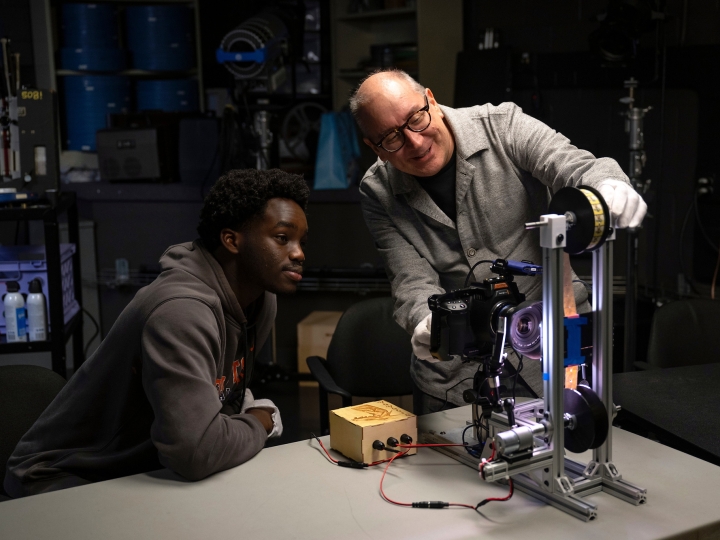
Seeing the Light
April 6, 2017
Advanced Lighting Design students experiment with different lighting techniques. Photo by Emily Paine
Technical theatre design students learn both cutting-edge technology and creative vision
Advanced Lighting Design students enter Harvey Powers Theatre through a door at the back of the stage. Action starts right away as they collaborate to carry out one another's lighting plans, centered around a collection of objects — a speaker, a large box, two cylinders and a mannequin wearing a cape. They are in this together, learning what works, what doesn't and why.
At the helm is Heath Hansum, lecturer, lighting and sound design/production manager and co-director of the theatre program. The students move the class forward as he walks across the stage answering questions and stepping away so they can experience the creative process for themselves.
Hansum says that understanding all of the elements central to technical theater takes practice. "Students must learn to become a visual voice for the director of any production they work on," he explains. "Being able to see it completely in your mind's eye is the goal." The class put its skills to the test by lighting the spring Choreographer's Showcase on April 7.
Students use the program Vectorworks to develop previsualization design skills and understand color, light and intensity. Before bringing them to the stage, they review their designs together in the classroom.
"What about the floor?" Hansum nudges one student who has forgotten to include one in his design. "Remember, the floor is a pretty large reflective surface."
Things have changed since technical theater employed more manual techniques. "It isn't just plugging a light in and turning a circuit on," says Hansum. "Now, you're dealing with networks and control cabling, and that can be difficult. It's important that students know how to use current industry tools, but those tools are always changing. At the same time, you don't want to forgo the history and foundation of technical design."
In the past, designers used gel filters to change light color, but now individual lights include multiple colors and textures.
"It's a great time to be a lighting and sound designer, because you have so much more control than you used to," says Hansum. "For the fall dance concert, we sat at the computer console and chose from a couple hundred lighting fixtures, half of which were color agile, which means we could remotely change the color and texture that they produce at any given time."
Hansum's entertainment technology assistant, Ray Ockenfels, agrees. "My favorite element of design is lighting, and the equipment in our inventory is both robust and diverse, allowing us to create a myriad of different worlds for the productions we put on," Ockenfels says.
While the audience might not ponder the work of technical designers, it is a central part of the collaborative team that creates productions, a process that involves a lot of give and take. "We are all looking to tell the same story as we work with each other's design in mind," says Hansum.
While many technical design students major in theatre, engineers and others take Hansum's classes as well. "Some of our best students are biologists or marketing students who stroll through the door, work on a show and find that it's really interesting and challenging," says Hansum. "It's fun to watch them go through that metamorphosis."
Students also learn there are jobs for technical designers. Graduates have gone on to careers in everything from technical theater to designing transport vehicles for the Army. "What we do is like the internal workings of a clock," says Hansum. "It's very precise and needs to be just so — elegant in its own right, but ultimately serving a purpose that most people don't end up noticing in the end."

